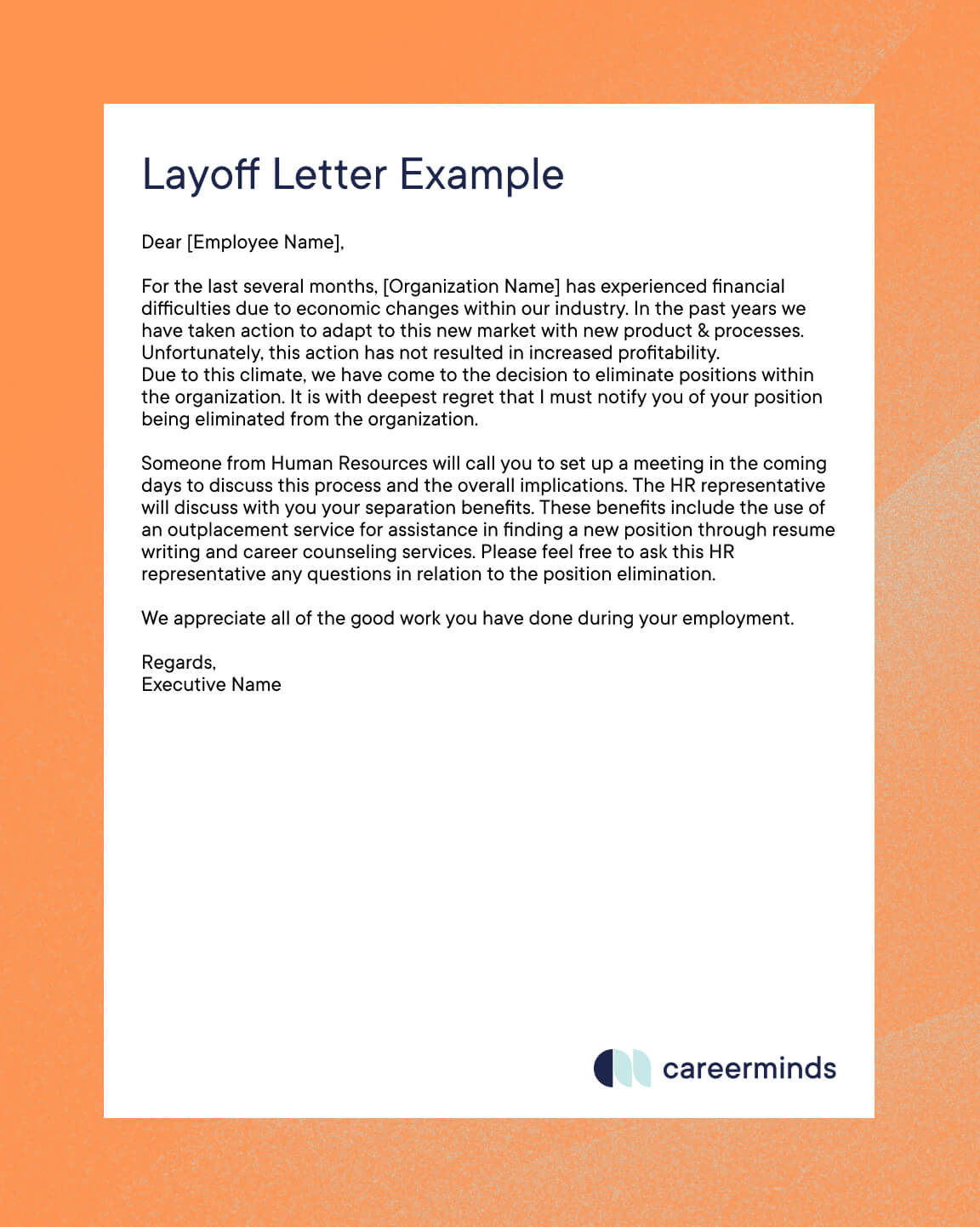
Preparing for a RIF?
Download our Essential Guide to Handling a Layoff
Request Pricing
Compare our rates to other providers
Layoffs can happen to any company. Whether it is because of financial issues, a move to rightsize the company, a preemptive layoff due to workforce planning reasons, there are tons of triggers for a RIF to occur. However, in order for all of them to go smoothly, you have to understand how to write a layoff letter that is both ethical and legal.
Notifying employees that their jobs are being affected by a layoff can be stressful to say the least. One of the best ways to handle it is with a meeting and a letter. We’ve already covered how the layoff meeting should go in a previous blog post. You can read that here.
Today, we’re going to examine how to write a layoff letter that gets the job done while also addressing the employee in the best way possible.
Let’s get into it.

Starting a Layoff Letter
Like any letter, the layoff letter needs to start by addressing the employee by name and getting straight to the point.
While it may seem like an okay idea to beat around the bush and break the news lightly, it’s not. Nothing you can possible write in this letter is going to make the employee happier to receive it. So, start the letter quickly by saying what is going on.
Something like this:
“Dear [Employee Name],
For the last several months, [Organization Name] has experienced financial difficulties due to economic changes within our industry. In the past years we have taken action to adapt to this new market with new product & processes. Unfortunately, this action has not resulted in increased profitability.
Due to this climate, we have come to the decision to eliminate positions within the organization. It is with deepest regret that I must notify you of your position being eliminated from the organization.”
Explain that the company is downsizing due to whatever reason and that their job is impacted. If you want to give a little more detail, wait until the second paragraph.
This brings us to the next point:
The Middle of the Letter
Okay, so we’re midway down the page now. You can take this time to explain a little bit about why the layoff happened. Just like the layoff meeting – which you will still have to have, by the way. Layoff letters don’t get you out of having a conversation even if they overlap in content – you should explain that this is a move based on X reasons.
Don’t put blame on the employee. Don’t try to console them too much either. Explain, openly, why your company is downsizing.
For example, you could say this from the letter example above:
“Due to this climate, we have come to the decision to eliminate positions within the organization. It is with deepest regret that I must notify you of your position being eliminated from the organization.”
This shows that you care while also telling them what is going on. It consoles but not too much. You’re not in there apologizing and trying to make the process feel better.
When learning how to write a layoff letter, the most important thing to remember is that this letter has to be professional, a bit personal, but – most importantly – honest. That means you have to keep a bit of distance in your writing while also knowing when to bring it in.
The Middle: Part Two
The middle actually has two parts to it. (Surprise!) The first, as we just said, is all about alerting the staff member of what is happening and how they are impacted. That part needs to be short and to the point.
Next, you need to transition the letter to setting up the layoff meeting. This involves stating that a member of HR will reach out to the staff member with a phone call to set up a time to go over the layoff process.
Alert the staff member that benefits will be discussed during this meeting. You can let the staff member know that there will be outplacement services included in these benefits in the letter, though, because it lets them know right off the bat that they won’t be going through this transition alone, which can ease tension.
Here’s an example of how this section can look:
“Someone from Human Resources will call you to set up a meeting in the coming days to discuss this process and the overall implications. The HR representative will discuss with you your separation benefits. These benefits include the use of an outplacement service for assistance in finding a new position through resume writing and career counseling services. Please feel free to ask this HR representative any questions in relation to the position elimination.”
You can also add in how severance works, too, if you have a policy on paper. For example, if severance pay is based on how long the employee was with the company, you can reiterate that policy in this letter. Just make sure you don’t end up explaining everything because that’s what the meeting is for and you don’t want to send the staff member a book – just a notification and brief explanation.
HR needs to be aware that people will likely have a lot of questions for this meeting. So make sure you plan out what needs said with a script. Using a script keeps you on task and helps the meeting move forward while also making sure that you listen to the staff member and let them say what they need to say. You can learn more about layoff scripts here:
Let’s now move to the end:
The End of the Letter
This section of the letter is super short. Really, you just want to thank the employee for all they have done at the organization and then sign off.
Again, it’s important to stay on task here. Don’t go on and on after you have explained what needs explained. You can simply end with a one sentence send off and then start to call those who are impacted by the event.
Here’s an example:
“We appreciate all of the good work you have done during your employment.
Regards,
Executive Name”
That should conclude your letter and allow you to send it off. However, you also have to make sure you handle the event in a legal way, which means checking in with your legal team, especially when you are letting go a group or have staff members that are over the age of 40 years old.
Legal Compliance and Layoffs
Knowing how to write a layoff letter is one thing. Making sure you are following all of your local, state, and federal laws is another.
Now, it’s impossible for us to go through all of the different laws that impact various regions of the US. Plus, we are not lawyers.
The best way to handle this process is to work closely with your legal counsel or team to make sure you are doing everything appropriately, ensuring that your organization is not breaking any laws or opening itself up to lawsuits because someone wasn’t let go properly.
If you follow all of the tips here, you will be well on your way to having a well-rounded and well-crafted layoff letter that is ready to be sent to your outbound staff members. We also recommend using outplacement services to make sure the whole process goes over smoothly. You can learn more about those services here.
Learning how to write a layoff letter? Download our sample:
In need of outplacement assistance?
At Careerminds, we care about people first. That’s why we offer personalized talent management solutions for every level at lower costs, globally.


